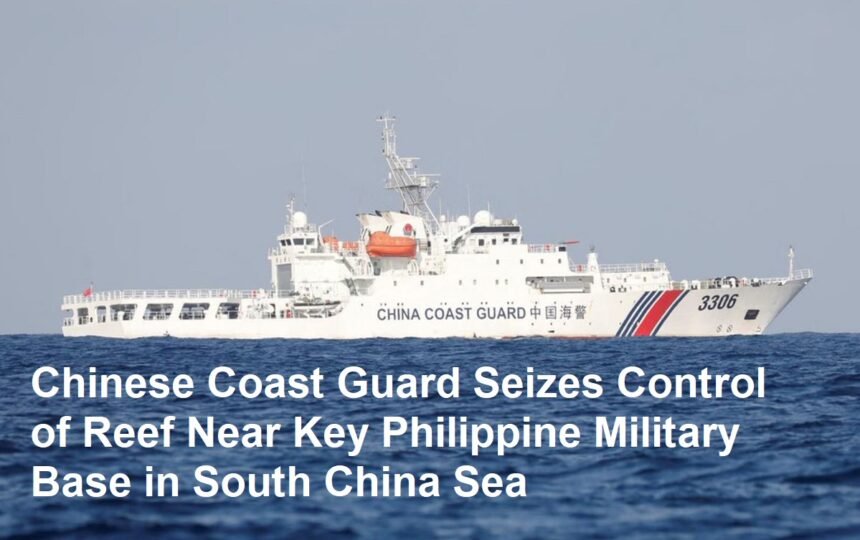In a significant escalation of tensions in the South China Sea, the Chinese Coast Guard has taken control of Sandy Cay, a small but strategically important reef located just over 3 kilometers from Thitu Island (known as Pag-asa in the Philippines). Thitu Island hosts a major Philippine military outpost, including a military-grade runway and a civilian population of around 250 residents.
The Incident
Chinese state media reported that in mid-April 2025, Chinese Coast Guard personnel landed on Sandy Cay reef, unfurled the Chinese national flag, and declared the enforcement of “maritime management” and “sovereign jurisdiction” over the area. Photographs released by Chinese state broadcaster CCTV showed coast guard officers standing on the reef and raising the flag as a symbolic assertion of China’s claim.
The reef, part of the disputed Spratly Islands chain, is also claimed by the Philippines, Taiwan, and Vietnam. China refers to Sandy Cay as Tiexian Jiao and has long asserted sovereignty over much of the South China Sea, a claim contested by several neighboring countries.
Philippine Response
The Philippine government has categorically denied that China has seized or permanently occupied Sandy Cay. Officials in Manila described the Chinese claims as “outright lies” and part of Beijing’s disinformation tactics. On the same day as the Chinese Coast Guard’s reported actions, the Philippine Coast Guard and Navy conducted a mission to Sandy Cay, unfurling the Philippine flag on two of the three sandbars that make up the reef.
Philippine authorities confirmed the presence of Chinese vessels near the reef during their mission but denied any interference or confrontation. The Philippines maintains that it continues to exercise sovereignty over Sandy Cay and the surrounding waters.
Regional and International Context
The incident comes amid heightened tensions in the South China Sea, a vital maritime corridor through which trillions of dollars in trade pass annually. The area is rich in natural resources and has been the subject of overlapping territorial claims for decades.
The timing of China’s actions is notable, coinciding with the annual “Balikatan” joint military exercises between the Philippines and the United States. These exercises, which include integrated air and missile defense simulations, are viewed by Beijing as provocative and destabilizing to regional security.
China’s move to assert control over Sandy Cay is seen as a message not only to Manila but also to Washington, signaling Beijing’s determination to enforce its territorial claims despite international criticism.
Strategic Importance
Sandy Cay’s proximity to Thitu Island makes it strategically significant. Thitu Island is the largest of the Philippine-occupied Spratly Islands and serves as a key military and civilian outpost. Control over nearby reefs like Sandy Cay could enhance China’s ability to project power and monitor activities in the area.
The reef itself is uninhabited but has seen increased activity from claimant states in recent years, including scientific missions and flag-raising ceremonies.
Broader Implications
This development adds to the complex and volatile situation in the South China Sea, where China has built artificial islands and military installations on several reefs and shoals. The Philippines and other claimant countries have sought international legal rulings and diplomatic support to counter China’s expansive claims.
The United States has repeatedly emphasized freedom of navigation and overflight in the region, conducting naval patrols to challenge excessive maritime claims. The ongoing military cooperation between the U.S. and the Philippines underscores the strategic importance of the area.
In summary, the Chinese Coast Guard’s seizure of Sandy Cay reef near a major Philippine military base marks a significant escalation in South China Sea disputes. While China asserts sovereignty and control, the Philippines denies any loss of territory and continues to assert its claims. The incident highlights the ongoing geopolitical tensions and the delicate balance of power in this critical maritime region.









